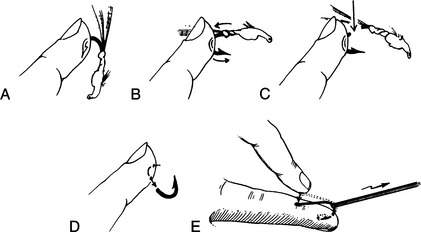PROCEDURES
SUBCUTANEOUS INJECTION
Subcutaneous (just below the skin) injection of epinephrine is used to manage a severe allergic reaction. The injection may be performed with a preloaded syringe (already containing the medicine in the barrel—see page 491) or may require that the medicine be drawn up for administration. After you wash your hands, follow these instructions:
1. Select the proper syringe and needle. For the treatment of an allergic reaction, a syringe that holds 1 milliliter (mL) is necessary, commonly equipped with a 25- or 27-gauge needle (the larger the gauge number, the smaller the diameter of the needle).
2. Never touch the metal of the needle with your hands.
3. Never share needles (never use the same needle to inject multiple people).
4. If the medication is in a preloaded syringe, be sure to see that the amount of medicine does not exceed the dose you want to administer. Be certain not to inject too much medicine.
5. If the medicine is in a glass vial, flick the vial a few times with your finger to drive the air bubble to the top, and then snap the vial open at the line marked on the glass at the neck (Figure 247, A and B). Draw the proper amount of medicine to be administered up into the syringe (Figure 247, C). In the case of epinephrine, this will be 0.3 to 0.5 mL for an adult, and 0.01 mL/kg (2.2 lb) of body weight for a child, not to exceed 0.3 mL.
6. If the medication is in a glass bottle with a rubber top, wipe the top of the bottle with alcohol, stick the needle through the rubber, and draw up the desired amount of medication. If you cannot draw the medicine out of the bottle, you may need to inject some air into the bottle first (use the same entry into the bottle to inject air in and to draw medicine out).
7. Before injection, point the needle upward, tap the syringe a few times to float the air bubbles to the top, and squirt out any air that is in the syringe (Figure 247, D and E). You should be left with only medicine. Try not to inject any air.
8. Wipe off the skin with alcohol or with soap and water (if no alcohol is available) where you intend to administer the medicine. The easiest place to inject epinephrine is on the lateral arm at the shoulder.
9. Pinch the skin up between your fingers, and quickly plunge the needle in just under the skin at a 15- to 30-degree angle to the skin (Figure 247, F). With the needle in the skin, gently pull back on the plunger, to see if blood enters the syringe. If it does, you have inadvertently entered a blood vessel, and you should draw back the needle until no blood is returned. If no blood is returned, firmly plush the plunger and inject the medicine. Quickly remove the needle from the skin, and gently massage the injection site.
Again, when administering an injection, never share needles between people.
FISHHOOK REMOVAL
If a fishhook enters the skin, gently scrub the skin surrounding the entry point with soap and water. After the skin is clean, apply gentle pressure along the curve toward the point while pulling on the hook. If the hook is not easily removed, this means that the barb is caught in the tissue (Figure 248, A).
Stay updated, free articles. Join our Telegram channel

Full access? Get Clinical Tree






